-----
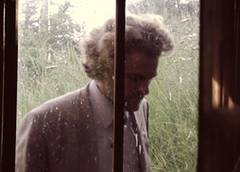
Air
Florian Graf and Fabrizio Fracassi, CH/DE 2010, 6'55", eO
A short mockumentary about the distinguished artist Olf Graphenheim – creating a new piece of art in the Swiss Alps.
-----
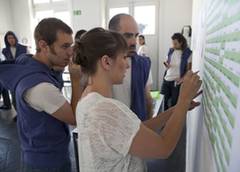
The Man Who Was Everywhere II.
Laurence Payot und Juan Morard, FR 2010, 6'02", eST
Saturday 26 June, in Fribourg, a strange man was reported. Some people saw him at different places at the same time, some say they were followed, other say they saw him come and go from opposite directions… For the Belluard Bollwerk International Festival, Laurence Payot proposed a performance that would infiltrate in the streets of Fribourg, and create a new urban myth. Like a theatre without walls, a staging of the everyday landscape, the work reveals common fears of the unknown and stranger, of the clone and the look-alike… For the performance, 23 men, from 20 to 30 years old, 1meter70 and 1meter85 height wore black shoes, blue jeans, grey T-shirts, purple hoodies, and white plastic bags, and wander through the streets of the city at a timed pace, following a precise route, all adopting the same attitude, and responding to the curious passers-by with a mechanical "I don’t have the time".
-----
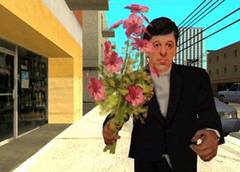
Kunst und Gesellschaft im Dialog I – III
English title: A dialogue between Art and Society I-III
Sebastian Blank, DE 2008/2009, part I: 6'02", part II: 4'17", part III: 3'33"
The trilogy by Sebastian Blank is a series of machinima videos, which are shot within a computer game. Sebastian Blank has therefore modified the game »GTA San Andreas« and placed (art) objects into the existing game world. He then put himself into the observer’s position. As a result of the modifications, situations evolve, where computer driven inhabitants of the virtual world are confronted with art - something the makers of the game could not foresee. In different situations Blank alleges an intentional behaviour, which in context with the objects, makes the people become performance artists. This, and the adaption of a video by Pipilotti Rist, also poses the question about the real consequences of virtual actions.
(Sound in Part III by Anders Guggisberg & Pipilotti Rist)
-----
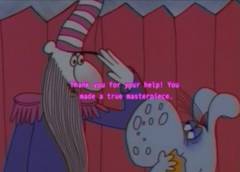
FTTSZT (s.r.a.w. rats)
Dávid Adamkó, HU 2009, 6'58", eST
What helps to shape the perception of art and the artist in society? FTTSZT s.r.a.w. rats shows the idealized romantic career of the creative practice using a Hungarian cartoon from the 1980s. This, juxtaposed against Hollywood science fiction movie footage contextualizes the creative act as a cataclysmic cosmic event.
-----

Bukarest 1992
English title: Bucharest 1992
Adrian Alecu, RO 2002, 6'32", gST
During the 80s a video camera, if existing in private life, was primarily used to document a variety of family ceremonies like weddings or baptisms in Romania. In my point of view, the found material, on which the work "Bucharest 1992" is based, stands for the place and the time given in the title. You can find the disorientation, which dominated the society of Bucharest after the collapse of communism, in the pictures of the video.
-----

Kunstdefinitionen
English title: Definitions of Art
Yuri A, CH 2004, 5', gO
5 characters emerge from snow globes to discourse on the definition of art: a swiss without any relation to art is speechless. A body builder shows his muscles and makes an attempt to explain art, and a blind artist finally bursts out laughing as she realizes that art only exists as a definition.
Path to follow
-----

Traces of an Elephant
Vanessa Nica Mueller, 2011 DE, 27', gST
"Traces of an Elephant" is a reflection on different attitudes towards the film "Elephant" directed by Alan Clarke (Belfast, 1989). It features a number of interviews that deal with Clarke's controversial television drama. Along with their personal memories of the film, the interview partners also reminisce about the structual changes in the city of Belfast during the last twenty years. The documentary approach and the intensity of Clarke´s fictional film coalesce.
-----
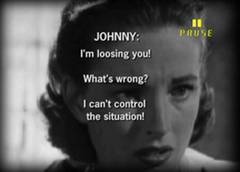
Johnny's video
DOPLGENGER (Isidora Ilic & Bosko Prostran), 2006 SRB, 2'22", eOF
"Johnny's video" deconstructs the representation of women on film. Experimenting with found footage, this video creates a meta-narrative, which could be traced back to the feminist film theory of Laura Mulvey. Male spectator controls female image...
-----
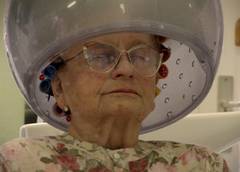
Glebs Film
Christian Hornung, 2009 DE, 27'25", gO
Gleb runs a small hairdresser’s shop in Hamburg-Altona. It’s the only shop in the street and for many of his elderly clients, the visit in the salon is the highlight of the day. The solitude of these people preoccupies Gleb, but simultaneously it stimulates his vivid imagination. While giving perms and darkening eyelashes, he tells his customers about his idea of a film which involves an unhappy man, a lonely woman, and a hairdresser for whom, of course, a very special part is reserved. Thanks to the great interest of Glebs listeners, the story often takes surprising turns. At the same time it provides the frame for a cinematic portrait of a passionate storyteller.
-----

What Do You Think Of Me?
Kika Nicolela, 2009 BR, 16'19", eUT
"The piece was originally created during a residency in Turku, Finland where the artist asked gallery goers to film her with a video camera and to narrate their impressions of her in Finnish. Since the language barrier prevented Nicolela from immediately understanding their comments, she stands before each spectator completely unaware of their perceptions and only able to respond to their smiles, laughter and other outwardly physical gestures. Although it is Nicolela who occupies the screen, her voice is rarely heard. Instead, it is those who wield the camera who contribute to the video’s defining narrative."
Extracted from the essay This Is Uncomfortable, by Arpi Kovacs and Gabrielle Moser
-----
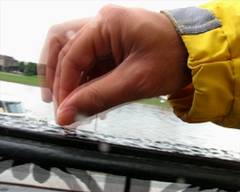
Dresden Hand
Neno Belchev, 2010 BG, 8'22", eST
Everything until now is rambling. I feel myself as a speechless piece of Styrofoam, crashed against the rocky coast by the waves.
-----
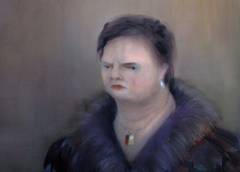
Maria
Eszter Szabó, 2010 HU, 1'25", eST
The video is based on a painting, which I painted in 2009. The painting portraits a fictive person called Maria. In the video this portrait becomes „alive” and complains about the painting. Maria is criticising it, because she thinks it doesn’t resemble her.
-----

Lecture (Contemporary Art for Parents)
Vesna Bukovec, 2002 SLO, 7'53", eST
How does one explain contemporary art to your parents? I organized a "lecture" and tried to explain to my parents the key moments of art history which,, are in my opinion most significant for the development of contemporary art. We also talked about the art market, institutions and evaluating problems. The video is part of the project Contemporary Art for Parents, 2002 (video, digital prints).
-----

Film about Unknown Artist
Laura Garbštiene, 2009 LT, 11', eO
An unknown artist visits a memorial plate, dedicated to unrecognized forgotten artist(artwork by Konstantinas Bogdanas), located in the backyard of the Vilnius Art Academy. The artist feels guilty about being unknown and decides to travel to places of pilgrimage in Lithuania to repent.
-----
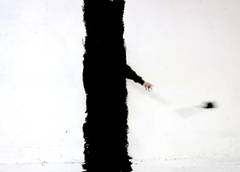
Linie
English title: Line
Johanna Reich, 2009 DE, 2'
In the video "Line" a high-resolution digital camera reaches its limits: a person dressed in black paints a black line on a wall. As a result of lighting conditions, the camera cannot differentiate between the black of the person and the black background. Artist and art fuse, the person seems to disappear in front of the camera. In times when we are observed by cameras every minute, "line" seems to be a humorous way to escape surveillance.
-----
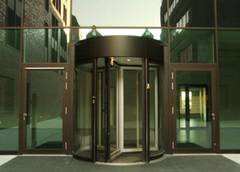
Spin
Janne Höltermann, 2010 DE, 3'20"
The video shows the entrance of an office building at Hamburger Hafencity. While the revolving door spins slowly the glass facade mirrors the surroundings. After a while the colours of the video become cooler and pale because a dissolve crossfades the exterior with the interior view. The transition between spaces proceeds slowly and barely noticeable. As a consequence it makes the viewer oscillate between interior and exterior space.
-----
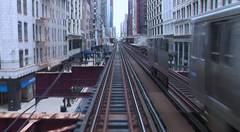
TheLoop
Jeroen Nelemans, 2010 NL, 4'42"
Since I was born in the Netherlands, my work has always been informed by the Dutch landscape and the horizon line. I am interested in our perception and how we are conditioned to experience the moving image, specifically how the digital image can be manipulated towards contemporary notions of sight and seeing. TheLoop is a video, that refers to the Dutch landscape-painting genre of the 17th Century. The world of Dutch art, during the Golden Age, serves as a system of values in which meaning is not 'read' but 'seen’, in which new knowledge is visually recorded. The concern of the nature of the image is part of a continuing concern of the verity of the images. TheLoop presents an image of a moving landscape that is broken into a triptych. Image and time are derailed and re synched to create a new landscape.
-----

Post Global Warming Survival Kit
Petko Dourmana, 2009 BG, 5'16", eO
When much of the sun light is blocked by dust and ashes (as in the nuclear winter scenario), seeing in infrared becomes the only survival mode. Based on this assumption, all imagery used in the project is filmed and projected in the near infrared part of the spectrum, which is invisible for the bare human eye but can be captured with modified digital cameras and camcorders and is visible with night vision devices (NVDs). Equipped with NVDs at the entrance to the installation, the viewers walk in the space surrounded by complete darkness, a reverberant bass soundscape and the sense of each other’s presence. Disoriented by the lack of light and confronted with the supernatural appearance of the physical world in infrared as seen through their "prosthesis", they are immersed into a completely new kind of sensory perception.
-----
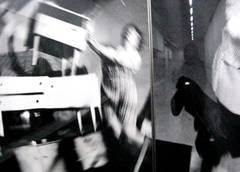
This art piece was seeking my reflection
Urssa Severa, 2011 RU, 3'20"
A serial of 60 sequential pictures of my reflexion in the art piece "Im Wahnzimmer" (In the Room of Madness) by Anna & Bernhard Blume, 1984, was shot and edited until it took the shape of a video stream. This video can be seen as a re-appropriation of Blume’s art piece. Their huge prints were placed on a wall in a museum. While I was contemplating, my reflexion as viewer was subtly interfering with the image bringing a sense of movement into it. Indeed movement was already very well expressed in Blume’s art work, but at this point the movement was coming from an outside point of action. Combat, invitation, triggering, drama, playful, mimetic, complementary or disruptive are some of the words to define the spontaneous engagement of the two surfaces, the pictures and my reflexion walking upon them.
-----
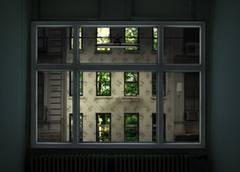
Revision
Julia Willms, 2007 DE, 5'52"
The audio-visual installation "Revision" addresses the difference between the acts of seeing and perceiving. There is a triangle relationship between the urban public space, a private interior and a natural environment, with no clear distinction between their borderlines. Urban architecture behaves much like a natural force, with rooms being flooded by pulsing red lights, street lamps providing sunshine and facades or entire interiors slowly melting away into exteriors. This tension creates another triangle relationship, that between the viewer, the physcial space he or she is standing in and the projected image. The projection of the architectural spaces is experienced as an extension and projection of an internal emotional space of the viewer and attributed to the phsyical space they are standing in.
-----

Are You Looking At Me?
Anne Hartog, 2010 NL, 10'22", eST
This film is a trilogy of shorts. In this work I observed and questioned the state of things. By framing and manipulating the world through film and words I try to challenge the perception of the spectator. The concepts ‘what’, ‘why’ and ‘where’ are of main importance. ”Truth, after all, wears a different face to everybody.” The only certainty in this visual work is that ‘they’ are not looking at the camera/me. But what is their object of attraction? This film consists of a single shot (repeated three times) and was shot in a small hutong in Beijing, China.
-----

Dew Point
Dorota Buczkowska, 2005 PL, 4'20"
In this work I'm observing simple physical processes, weather phenomena - unstable state of transition, where I find truly poetic stories. "Dew-point" plays with perception, it demands an effort to understand, what happens. This work focuses on the rationality of cognition processes and lays stress on imagination and intuition. As in my other works, I'm chasing physiological and emotional conditions of the activity of the human body. The red spot approaches and disappears – again and again.
-----
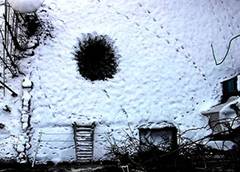
Schwarzes Loch
English title: Black hole
Johanna Reich, 2009 DE, 2'
An overhead shot of a snowy landscape. A figure in black removes the snow until it merges with the surface beneath the snow. The figure before the camera vanishes. Escaping in front of the observer into another space.
-----
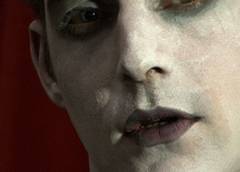
Prologue
Inez de Coo, 2010 NL, 5', eO
I use found sampled sounds from prologues (made between the 40s and 60s) and show pictures of an actor trying to lip synch the lines, to address the expectations of the viewer while watching a film. These prologues were originally created to make people feel a certain way or to elaborate a certain political agenda. However, out of context, they become a surreal commentary on the nature of film itself. It shows the actor as an automaton and yet also a person who makes mistakes and shows part of himself. The video keeps the relation between the viewer and the actor on the screen uncomfortably close.
-----
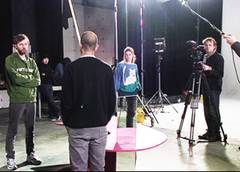
Talk Show
Malthe Stigaard, 2010 DK, 12'24", gST
I invite a group of participants to an installation and ask them what they see. I document their responses as they slowly become aware that the installation is not the work. It is actually the reactions of the participants that make up the actual work.
-----
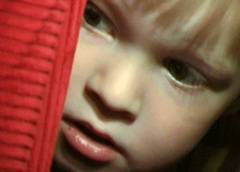
Cold Milk
Hanna Haaslahti, 2010 FI, 5'30"
A child sits in front of a TV and discovers the pleasure and pain of watching. The flickering screen attracts him and pushes him away, while manipulating the little spectators’ emotions and his whole existence. For a moment the tension becomes too intense and the child manages to escape from our sight into the blue void. The child only returns shortly to his seat to satisfy his and our pleasure of watching.
-----
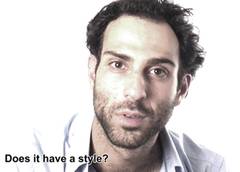
fiction is over
Marta Azparren, 2010 ES, 5'22", eST
"acta est fabula" is the latin phrase for "fiction is over", a formula that announced the end of theatre plays in the ancient Rome. The solo dialogue between creator and its audience it’s the work itself.
-----
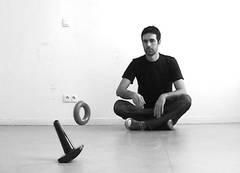
Installation
Vladimir Nikolic, 2009 SRB, 11'11", eO
What is it all about? This question occures often in my mind faced with contemporary art. So I came to the idea to write a play for two imaginary persons, who are observing a video and having a dialogue trying to understand what is going on in this work. Most of my doubts about contemporary art are stated in this work. (VN)
-----
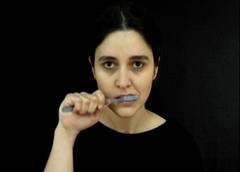
untitled
Hacer Kiroglu, 2007 TR, 2'54"
I perform a painful intervention on my own body, as a manifestation of my resistance or weakness to the fact, that I am forced to accommodate myself to the status quo of life.
-----
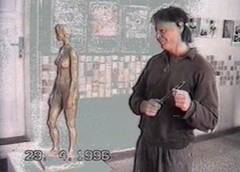
Dualität
English title: Duality
Jirí Janda, 1999 CZ, 9'17"
The performance "Duality" is part of the "Symptoms of the Existence Cycle", which is a cycle of 12 exhibitions, done during one year. Each of them was started with a performance, which is connected with the exhibited works. The works of art got modified and a new shape every month. At the same time, with these performances, I explored the question of who is actually the observer and who is the observed. I wore a smiling mask, in order to bloc with the verbal communication of the spectators, as well as to raise the question of who is behind the mask. Plenty of different emotions could be seen during these performances. Actually art is a mirror reflecting ourselves – and at the same time it is a way to our "real self"!
-----
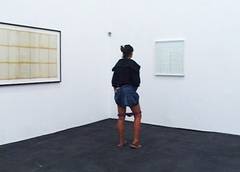
Cultural Guide
Déborah Ghisu, 2009 FR, 10'07"
This work exists in exchange between the object and the beholder. In this case, the relation is exacerbated by the erotic action. It's something like a protocol that plays with the expectations of a viewer, conditioned by contemporary art. Sex is a kind of tool to analyse a situation. In this case it's the perception of conceptual art. When I show myself masturbating in front of a work of art, I don't want to express my sexual independence. An error is introduced: the sight of panties damages for a few seconds the intellectual assessments.
-----
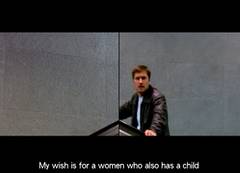
Escalating perception / the gaze
Christian Niccoli, 2004 IT, 7'33", gO, eST
In this video, an escalator within the metro station Potsdamer Platz in Berlin transforms into a location for a research of a partner. The attempt is to put in scene a flirt between adults carried up and down by an escalator and the observer. Unexpectedly, while they are moving up and down, the protagonists start addressing to the observer short sentences about themselves and their expectations of a new relationship, as if inviting him/her to a confrontation with their real necessities and wishes. These sentences are derived from interviews with Berlin-based women and men aged between 30 and 40, who, after a separation, started to perceive themselves once again as potential partners in a future relationship.
-----
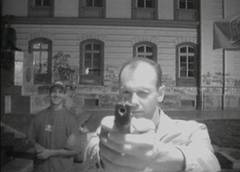
Noise
Zoran Todorovic, 1998 SRB, 23'22", eST
This video was recorded with an "open" camera, which enabled people to leave messages at public places: at a plaza in downtown Belgrade, in a psychiatric hospital and in prison. There were instructions put in front of the camera: "What do you have in your throat?" and "Press the button and record your message".
